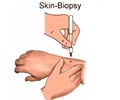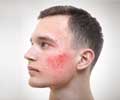Types and Symptoms
The three main types of pemphigus are vulgaris, pemphigus foliaceus, and paraneoplastic pemphigus.
a) Pemphigus vulgaris is the most common variety and accounts for 70% of the pemphigus cases. It is characterized by oral sores in 50-70% of affected people. These sores can spread to the upper part of the throat making eating very difficult. Skin sores are also quite common.
Although P.vulgaris may occur at any age, it commonly affects those between the ages of 40 and 60 years and is reported to be more prevalent among the Ashkenazi Jews. In some cases it is associated with the autoimmune disease Myasthenia gravis.
Application of firm pressure on ‘normal-looking’ skin produces a tear or sore (Nikolsky’s sign). This disease does not spread to any internal organs.
b) Pemphigus Foliaceus is the mildest form of the three types and is not as painful as P.vulgaris. It is characterized by crusty, itchy sores that initially erupt on the scalp and then move to the face, chest and back. Mouth sores are significantly absent. It is often mis-diagnosed as dermatitis or eczema.
c) Paraneoplastic Pemphigus is the rarest and the most severe type. This variant of pemphigus is often a complication of cancer and is particularly linked to lymphoma and sometimes to Castleman’s disease. It is often diagnosed before the tumor itself, when painful sores begin to appear on the lips, mouth and the esophagus. The lungs too are often involved causing constrictive bronchiolitis (Bronchiolitis obliterans). This is often irreversible although the skin disease can be improved by completely removing or treating the tumor.
Bullous pemphigoid is a chronic autoimmune disease that is characterized by blisters below the skin surface. Sometimes the mucous membranes are also involved. Another feature is that antibodies are raised against type XVII collagen found in the hemidesmosomes. Bullous pemphigoid is also known to affect dogs cats, horses and pigs.
Haley-Haley also known as familial benign pemphigus, is not an autoimmune disease but a kind of genetic skin disease that is inherited and is therefore excluded from the Pemphigus group of diseases.









